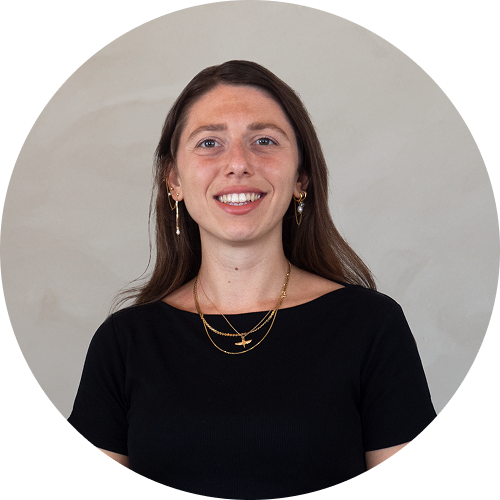The questions on this free Inductive Reasoning practice test are a true representation of the questions you'll face on the actual Inductive Reasoning Aptitude Test.
These Inductive Reasoning sample questions were specifically chosen from our full Inductive Reasoning test practice pack to help improve your score and ace your pre-employment process.
Free SHL Inductive Reasoning Test Questions and Answers
For a further in-depth review of SHL test sample questions, visit our free SHL practice test page or the All Inclusive SHL Preparation.
Sample Question 1
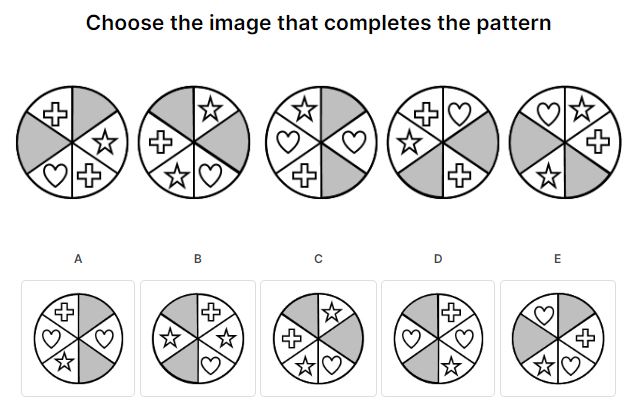
Answer:
The correct answer is (D)
Each circle is divided into six portions; three pairs of identical shapes are located in opposite cells; the grey pieces rotate clockwise. All the inner parts rotate in a counter-clockwise direction. It is not easy to recognise the presence of the three pairs. However, one can reach the same conclusions using other clues. For instance, one may note that the same couple of shapes appear in the first and fourth items of the sequence, as is the second and fifth items. It is only logical that the next item of the series will include two hearts located in the right and left cells. This reasoning should lead us to narrow the possible answer to options (A) and (D). Figuring out the grey portions' movement pattern leaves us with possible options (B) and (D). Combining these two conclusions, and we're left with choice (D) as the only option to comply with this problem's reasoning.
Before You Continue...
Below are 9 more sample deductive questions.
Hundreds more can be found on our All-Inclusive SHL Prep Course, designed to get you test-ready in the few days SHL offers for preparation.
It also includes an interactive interface mimicking the real test, video, PDF, and interactive guides, full solutions and explanations for each sample question, and detailed score reports.
Sample Question 2
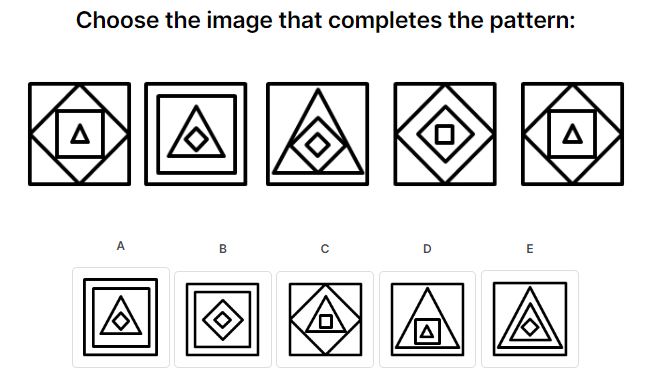
Answer:
The correct answer is (A)
The logic: The inner shape in one frame becomes the middle shape in the next frame; the central form becomes the outer shape in the next frame, and the external form becomes the inner shape two frames later.
Thus, the outer shape in the missing frame should be a square (just like the middle shape in the 5th frame), the central form should be a triangle (like the inner shape in the 5th frame), and the internal structure should be a diamond (like the outer shape in the 4th frame).
Frequency. Frequency questions involve a relationship between certain features in the question that influence other factors, like location, shape, number, etc. Are you looking for a way to practice for the SHL Inductive Reasoning test? Access a full-length Practice Test for the SHL Inductive Reasoning exam. Other Inductive Reasoning practice questions are included in Matrigma, and Cubiks Logiks preparations.
Sample Question 3
Which of the following boxes should replace the question mark (?) to complete the pattern?
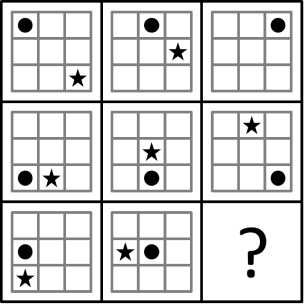
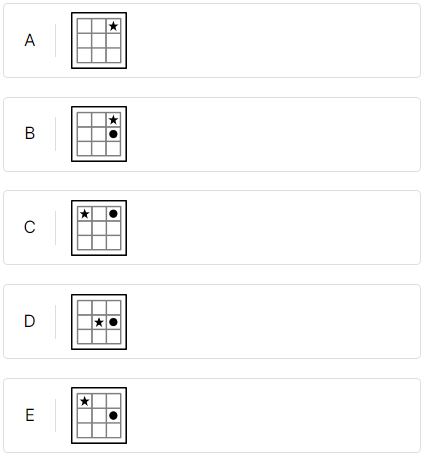
Answer:
The correct answer is (E)
In this matrix, there are two rules:
- The circle: Across a row (from left to right) the circle always remains in the same row but moves one column to the right in each successive frame. Down a column, in each frame, the circle is still in the same row but is in different columns.
- The star: Across a row (from left to right) the star always remains in the same column but moves up one row in each successive frame. The star forever remains in the same row down a column but moves one column to the left in each succeeding frame.
(In the upper-right frame the star and circle end up in the same position and the circle covers the star).
We can eliminate the answer (A) because it is missing a circle. We can further eliminate answers (B) and (D), because the star is in the wrong position, and the answer (C) because it has the circle in the wrong place.
Therefore, we are left with the answer (E) choice as the only correct solution.
Movement. Movement questions involve elements moving around and changing locations in the frames. Improve your Logical Reasoning skills by solving more Movement questions. Other Inductive Reasoning practice questions are included in Matrigma, and Cubiks Logiks preparations.
Sample Question 4
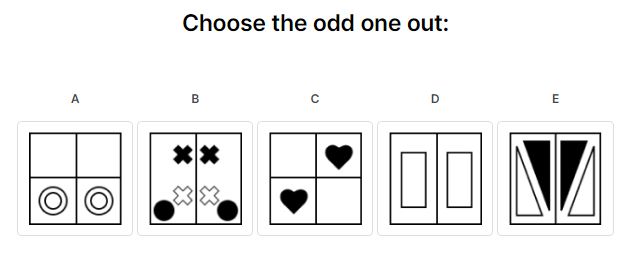
Answer:
The correct answer is (C)
The logic: In all of the options except for option three, a vertical line separates these boxes into two equal, symmetrical halves that mirror one another. If these boxes were pieces of paper that were folded vertically, the items in the boxes would be matching and perfectly identical. The right and left halves are mirror images of one another. This is not the case for option three. In option 3, there is no mirroring effect between the halves. Both hearts have to be on the top or on the box's bottom to be symmetrical.
You have probably noticed that the amount, type, and color of items are insignificant features and simply distracters.
Sample Question 5

Answer:
The correct answer is (A)
Every frame has four shapes (or shape-groups).
In all frames, the shapes grow with the addition of the first shape each time.
However, in frame A, the shapes double twice as much as the previous shape. Therefore the correct answer is A.
Distractors:
The shapes in frames B and C are ordered by size, which has no significance to the question since we do not look for rules broken by two frames. We look for rules broken only once.
An inductive reasoning test, also known as an abstract reasoning test or a logical reasoning test, assesses candidates' problem-solving abilities. Candidates are required to recognize patterns and consistency within sets of objects in order to predict trends in the future. Practice Abstract Reasoning and Inductive Reasoning test questions and give yourself an advantage over other candidates. Other Inductive Reasoning practice questions are included in Matrigma, and Cubiks Logiks preparations.
Sample Question 6
Please select the answer that completes the logical sequence matrix
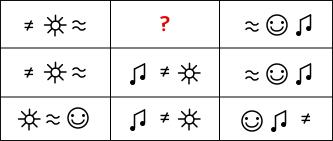
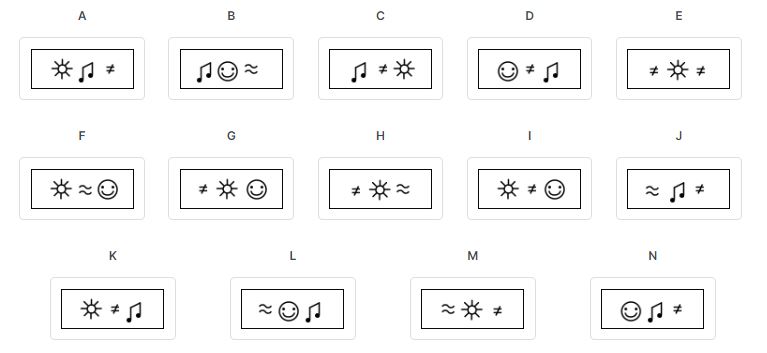
Answer:
The correct answer is (N)
Note that this question is complicated and based on complex logic. Therefore, if you did not get it right, do not despair and carefully read the explanation below.
It is tempting to choose answer (C), as it would create an identical row to the one beneath it, which would not explain the pattern or how the third row should be taken into account. Therefore, it is most likely a red herring.
The real pattern is as follows:
All the cells contain three out of five symbols: ≠ ☼ ≈ ☺ ♫, following the same order. For example, '☼' is always followed by '≈' and '≠' is always followed by '☼'. This can indicate that there is a sequence of symbols that "moves" throughout the cells.
To better understand this movement, focus on the complete rows. Starting from the left cell in the middle row and moving to the right, you can see that the symbols "move" one step to the right and then two steps to the right. This movement's logic is continuous throughout the matrix's rows so that the symbols "move" again one step to the right when moving from the right cell in the middle row to the left cell in the bottom row.
For instance, if you follow the '☼' through the rows, starting from the left cell in the middle row, you can see that it first "moves" one step to the right. Then, when moving to the right cell in the middle row, the'☼' "moves" two steps to the right, causing it to disappear (as it is now the 5th symbol in the sequence, whereas only the first three symbols can be seen in each cell). Continuing to the left cell in the bottom row, the'☼' moves one step to the right again, causing it to reappear (as it becomes the 1st symbol in the sequence).
Working backwards, you can see that the symbols "move" two steps to the left when moving from the left cell in the middle row to the right cell in the top row. Therefore, the symbols should "move" one step to the left when moving from the right cell in the top row to the missing cell, resulting in the next signs ☺ ♫ ≠.
Note:
Another way to solve the question is based on the observation that there are two identical cells in each column. In both outer columns, the identical cells appear first (from top to bottom), followed by a third cell where the symbols "move" one step to the left. Since the missing cell appears before the identical cells, you can guess that inverse logic should be applied, i.e., the symbols from the identical cells should be "moved" one step to the right to create the missing cell. Thus, the middle and right symbols in the missing cell should be '♫' and '≠' respectively, and the left symbol should be '☺' (since '♫' is always preceded by '☺'). This logic will lead you to the correct answer (N) – but at the expense of being uncertain about your answer choice. Thus, this method is a less preferable way to solve the question than the logic presented above.
Sample Question 7
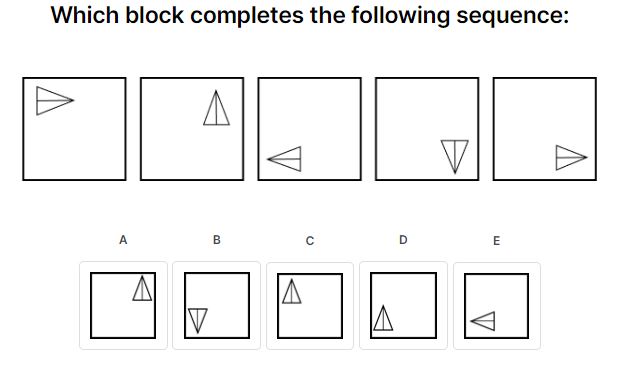
Answer:
The correct answer is (D).
Each frame contains a triangle. The triangle moves in two ways:
1. It moves clockwise between the corners of the square. It makes one movement from one frame to the next. Between the first and the second frame, the triangle moves clockwise one corner; between the second and the third frame, it moves two corners, and so on. This means the triangle should move five corners between the fifth and the missing frame.
2. Another way to look at it is that the triangle moves in a “z” formation in both directions. The triangle rotates 90 degrees anti-clockwise around its own axis between frames.
Based on the first rule you detected, it is possible to rule out answers. If it is easier for you to see the rotation pattern of the triangle, you can rule out answers (2) and (5). Vice versa, if the movement of the triangles between the corners is the rule you see first, you can rule out answers (1) and (3).
What is the difference between inductive and deductive reasoning? An inductive reasoning process involves drawing broad generalisations from specific observations. It goes from the specific to the general – identifying patterns, examining details, and forming theories. In contrast, deductive reasoning moves “from the general to the specific”. Essentially, it involves forming a theory and then predicting. Press to see more SHL Inductive Reasoning Tips that will help you ace the test. Other Inductive Reasoning practice questions are included in Matrigma, and Cubiks Logiks preparations.
Sample Question 8
Which of the following boxes should replace the question mark (?) to complete the pattern?
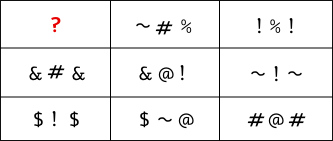
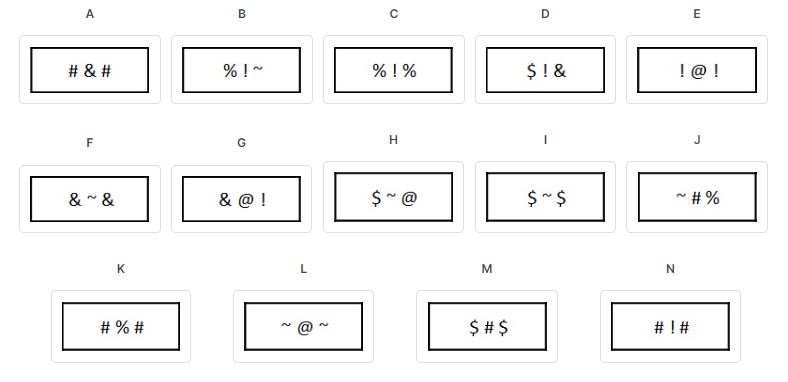
Answer:
The correct answer is (L)
The pop-up: In each row, the left cell consists of a duplication of the left symbol from the middle compartment and an addition of a new symbol between the two identical symbols. Thus, the correct answer is (L).
The complete logic: In each row, the symbols in the middle cell are a combination of the characters from the left and right (i.e. outer) cells so that:
The left mark in the central compartment is identical to the outward symbols in the left cell.
The right mark in the middle cell is similar to the middle mark in the right cell.
The central symbols in the left and central cells and the outer symbols in the right cell are different from all the other symbols in the row.
The only answer that follows this logic is (L).
Note: In the right column, the top cell's outer symbols (‘!’) are identical to the middle symbol in the central compartment is only a distraction. This logic does not apply to the rest of this column or any of the other columns.
Sample Question 9
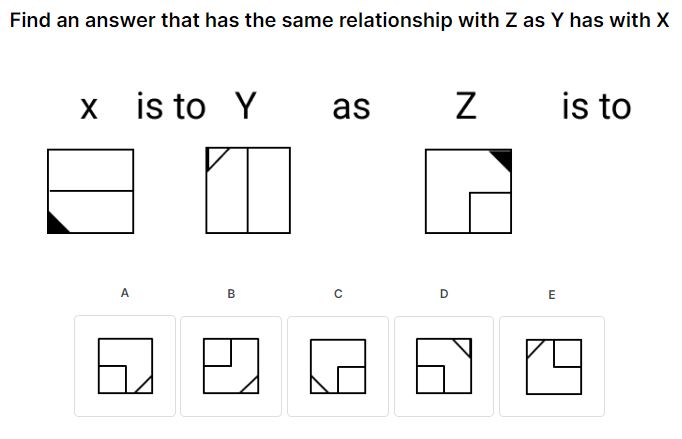
Answer:
The correct answer is (A)
The relationship between figure X and figure Y is as follows:
- Figure Y represents figure X rotated 90° clockwise
- The dark triangle becomes white.
The correct answer must have the same relationship as figure Z.
Answers (B), (C), and (D) can be eliminated, as they represent the shapes in figure Z in new locations; however, they are not rotations of the entire figure.
Answer (E) can be eliminated, as it is a 90° counterclockwise rotation of figure Z.
We are left with answer (A), in which the correct answer portrays figure Z rotated 90° clockwise, while the dark triangle becomes white.
Sample Question 10
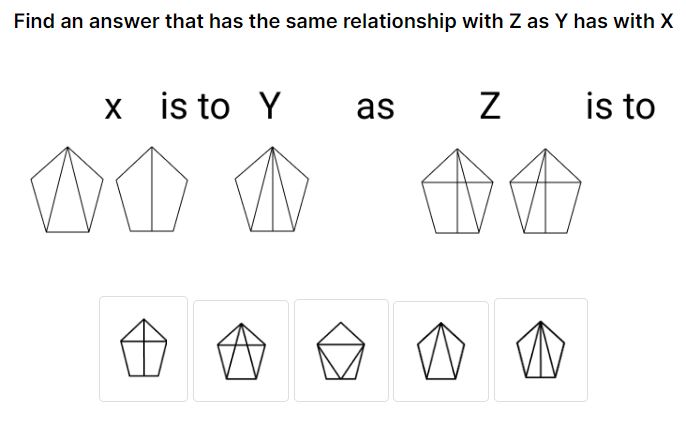
Answer:
The correct answer is (D)
The correct answer must have the same relationship as figure Z.
The relationship between figure X and figure Y is as follows: each line within the pentagon that is exclusive to one of the shapes in figure X appears in figure Y, while the lines that are shared by the two shapes in figure X do not appear.
Note that when examining the relationship between figures X and Y, one may very reasonably assume that figure Y is a combination of the two shapes in figure X. Based on this assumption, the correct answer would be a combination of the two shapes in figure Z. However, seeing as no such answer choice is given, this assumption must be dropped and a new one must be made. The new assumption should be made using the elimination process:
Answer (1) can be eliminated as it represents a shape that includes all of the similar lines within figure Z.
Answer (2) can be eliminated as the horizontal line running through the pentagon is shared by both shapes in figure Z.
Answer (3) can be eliminated as the horizontal line running through the pentagon is shared by both shapes in figure Z and because the diagonal lines which complete the form of a triangle are not included in either shape in figure Z.
Answer (5) can be eliminated as the vertical line running down the pentagon is shared by both shapes in figure Z.
You are left with answer (4), which is the correct answer, as each line within the pentagon that is exclusive to one of the shapes in figure Z appears, while the lines that are shared by the two shapes in figure Z do not appear.
It is common to assess inductive reasoning using Abstract Reasoning questions, in which test-takers examine figural data, look for patterns, and determine which figure should be the next, e.g., which figure should replace the empty cell in the matrix or which part of the puzzle is missing. Improve your skills with more Inductive questions or purchase the full Inductive Reasoning preparation.
Answer Index
| 1 | 2 | 3 | 4 | 5 |
| D | A | E | C | A |
| 6 | 7 | 8 | 9 | 10 |
| N | D | L | A | D |
Continue Practicing for the Inductive Reasoning Exam
Access more Inductive Reasoning practice tests and other valuable Inductive Reasoning prep materials so that you take the test while being as prepared as possible:
Master the SHL Assessment and Land Your Dream Job
It's all just a few clicks away...
Preparing for the SHL can give you an edge in a competitive job market. Focused preparation reduces testing anxiety and improves memory, logical skills, and solving speed.
Take advantage of thousand of sample questions with full solutions and explanations.

